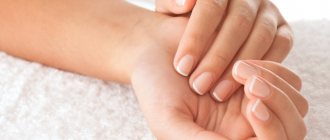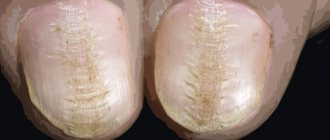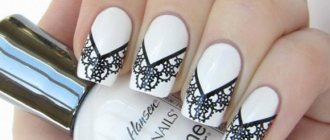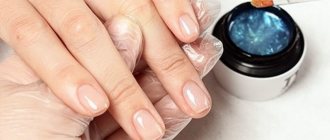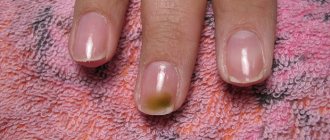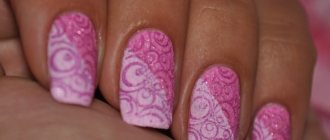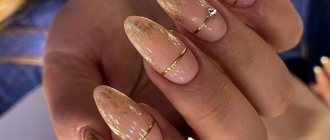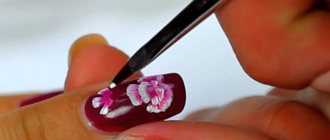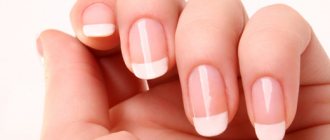The magic of charm » Health
If you look at our nails, you can see light crescents at their base. These are holes or lunulae. But have you noticed that they may not be on every nail, or they are clearly visible on one nail plate, but not on the other? This issue is worthy of consideration, because by the presence or condition of a hole on one of the nails one can judge the development of a certain disease in a person.
Official medicine supports the theory of diagnosing diseases by the shape, color, and type of surface of the nail. You can easily carry it out even at home on your own, and an experienced specialist can easily confirm or refute your suspected diagnosis. The condition of your nails will reflect problems with the large and small intestines, blood circulation, cardiovascular and endocrine systems.
What diseases can holes in the nails indicate?
Tibetan healers also believed that you can tell from a person’s hands whether he is healthy or not. They paid special attention to lunulae, believing that their shape and specific features could indicate internal disorders of the body.
note
The shape of the nail plate and the size of the lunula may depend on many factors, genetic predisposition and individual characteristics of the body.
The following external signs may indicate that it is time to think about a preventive visit to the doctor:
- uneven color at the base of the nail, stains;
- whitish spots on the nail plate;
- bumps, grooves, uneven shape of the nail bed;
- complete disappearance of lunulae (provided that they were there initially).
The shape and color of nails can be directly influenced by lifestyle. In girls who often exhaust themselves with diets, the nail plates can become thinner, brittle, and brittle due to a lack of nutrients. Nails can curl and break if you drink too much alcohol. Chronic diseases also make themselves felt. For example, in people suffering from diabetes, the holes may darken and the nails themselves may become covered with elongated grooves.
Helpful information
The disappearance of holes in the nails or their paleness can be a natural age-related change in older people. The holes of the little finger disappear first, then the ring, middle and index fingers. The holes at the base of the thumbs turn pale last, as they take up the most space.
Even if you feel well and have no specific symptoms of the disease, you should pay attention to the holes. They, as an indicator of health, can indicate the presence of pathological processes in the body.
- Large, identical on all nails - a sign of good health and good immunity.
- Small, barely visible ones may indicate circulatory problems.
- The nail has become convex at the base - indicates serious problems with the lungs or the risk of developing tuberculosis.
- Plates concave inward indicate a lack of iron sources in the diet.
- Flattened, flat nails are most often found in those whose bodies are affected by helminthic infestation.
- If the nail plate is so stratified that the lunula is not visible , this indicates a strong slagging in the body.
Palmistry
The hole on the nail is studied not only by Tibetans, but also by palmists around the world. Palmistry answers the question of why a person does not have a white arch on his hand in a slightly different way. Many palmists believe that if the crescent moon is missing, then this indicates a person’s attitude towards the opposite sex.
If a man has a similar pathology, then most likely he is a bachelor who, moreover, does not seek to get married. Quite the contrary, he prefers an open relationship. A missing hole on a man’s nail may indicate his fear of family life.
If the hole on a woman’s nail is not visible, then most likely she is unlucky in marriage, or she cannot get married at all.
It is quite possible that a woman without crescents, just like a man, prefers freedom to marriage.
Palmistry studies not only whether there is a hole on the nail or not, but also its color, as well as the shape of the nail itself. At the same time, palmists do not reject such a version as the relationship between the state of the white crescents and health. There are other versions. The meaning of the missing arch on the nail plate also depends on which finger the pathology is observed on. These values should not be taken with absolute confidence. But you can think about the possibility of changing something in your life.
Organs and systems of the body for which each of the holes is responsible
The Japanese believed that the body's hidden reserves could be stimulated by massaging the hands, because each finger corresponds to a specific organ. In Tibet, they believed that it was possible to make a conditional diagnosis just by looking at the holes in the nails.
- The lunula is the largest and most noticeable on the thumb Responsible for the functioning of the brain and lungs. May be greatly reduced in smokers or in people with serious mental disorders.
- On the index finger – responsible for the gastrointestinal tract and pelvic organs. Disappears for problems with the stomach, pancreas, liver and inflammatory processes occurring in the pelvic organs.
- The middle finger reflects the state of the cardiovascular system. The disappearance of the hole may indicate the development of vegetative-vascular dystonia, blood pressure disorders or arrhythmia.
- On the ring finger, the hole is not the most noticeable, but still its complete disappearance may indicate the need to visit an endocrinologist to make sure the thyroid gland is healthy.
- The little finger socket may normally be absent or completely invisible. However, its sudden and complete disappearance may indicate severe slagging of the small intestine. This sign signals the need to detoxify the body.
Treatment
The absence of a fingernail socket may be a sign of pathology. For example, if there is no crescent on the index finger, then there may be a disruption of the kidneys or endocrine system. If the hole in the nail of the middle finger is not visible, then the person may have serious problems with blood.
According to the results of observations of Tibetan scientists, it was noted that most often a person has an absence of white arches on the little fingers of the hands.
This is due to the fact that the adult intestines become clogged with waste. All nail holes gradually disappear. The older a person is, the smaller the nail hole becomes.
Even if a person does not have a nail hole, this does not mean that it is necessary to begin self-medication. Such signs indicate the need to examine the body and change lifestyle. Treatment should consist of eliminating the cause of the pathology, and not directly aimed at restoring the condition of the nail plates of the hands. This method will not give results.
What does the color of the lunula say?
Even from a medical point of view, a change in the color of the lunula is a rather valuable diagnostic sign:
- White color is normal. Ideally, lunulae should be just a few shades lighter than your skin tone. If the nail becomes covered with whitish spots, this indicates disturbances in the functioning of the heart muscle.
- Yellow spots indicate circulatory disorders in the brain. You should sound the alarm if yellowing of the nails is accompanied by a severe headache, dizziness or floaters in the eyes.
- Gray is an indicator of severe physical exhaustion or problems with nutrient absorption.
- A blue tint may indicate a copper metabolism disorder.
- Blue or purple color of the lunula indicates a lack of oxygen in the blood. This problem occurs in people suffering from night snoring and breathing rhythm disturbances.
- red with heart failure, liver cirrhosis and psoriasis. It is important to analyze and remember what symptoms have bothered you recently.
- Black bases of the nail can appear after a severe bruise, pinching, burn, injury, and even gas poisoning.
Size of holes on different fingers and diseases
We figured out the color and location of the lunula. Now let's try to understand what features the size of the holes on the fingers can tell about.
- The holes occupy more than a third of the nail plate - this sign most often indicates low blood pressure, arrhythmia and other problems in the functioning of the cardiovascular system.
Large lunulae are most often found in people whose professional activities involve severe physical activity or increased levels of stress.
- The holes barely reach the cuticles - a sign of poor metabolism, deficiency of iron or vitamin B12 in the body. Such holes are often found in vegetarians, vegans and people who have excluded red meat from their diet for dietary purposes.
- There are no holes at all - often they are not visible in young children, due to the fact that the nail plate is too small, or in people with a trapezoidal nail shape.
- A longitudinal stripe in front of the hole may indicate a sharp increase or decrease in blood sugar levels. This happens on diets and when the diet is incorrectly prepared.
- They are located chaotically - their size and location on the left and right hands do not match. A rather rare phenomenon, which is often transmitted through the paternal line, as well as the shape of the nail and fingers.
note
The sudden disappearance of lunula is interpreted in medicine as a violation of blood circulation and heart rhythm. Be sure to visit a therapist and cardiologist if you suspect you have a similar disease.
Classification and stages of development of onychodystrophy
At the moment, there is no unified classification of onychodystrophies. Based on their origin, they can be divided into two groups:
Congenital onychodystrophies develop as a result of gene mutations and are inherited. The last group of diseases are in turn divided into:
Let's take a closer look at each group of diseases.
Isolated onychodystrophy
This subgroup of diseases includes: brittle nails, onychoschisis, Bo's furrows, onycholysis, onychogryphosis, leukonychia, the formation of longitudinal grooves and hyperpigmentation. Most often they develop as a result of ultraviolet irradiation, mechanical and chemical damage.
Brittle nails are the most common deformation of the nail plate. It is accompanied by breaking off the free edge of the nail with the destruction of all its layers. Occurs predominantly in women. The reasons for brittleness are frequent contact with hot water and abuse of manicure.
Onychoschisis is a transverse separation of the nail plate without signs of inflammation. With this disease, the nail grows correctly to the free edge, after which the nail plate splits into 2-3 layers. The most commonly affected nails are the index, middle and ring fingers. The reasons are repeated minor mechanical injuries, including improperly performed manicure, playing stringed musical instruments, etc.
Bo's groove (manicure onychodystrophy) is another common type of dystrophy. Characterized by the appearance of a transverse groove on the nail plate. It often forms on the nails of the thumb, index and middle fingers. The reason is a violation of the technique of removing gel polish using cutters.
Onycholysis is a common pathology in which the connection between the nail plate and the nail bed is disrupted. The separated part of the nail may take on a white-gray tint. The surface of the nail, as a rule, remains smooth, but if a fungal or bacterial infection is attached, the nail plate becomes uneven, rough and bumpy, thickened or brittle.
There are quite a few causes of onycholysis. These include:
Onychogryphosis is a sharp thickening (hypertrophy) of the nail plate with the acquisition of a convex shape. As it grows, the affected nail begins to curl like a spiral or horn. The color of the nail plate becomes dirty yellow or brown.
The exact cause of onychogryphosis has not been established. The participation of external and internal factors is assumed. External triggers include various injuries to the nail apparatus, frostbite, wearing tight shoes, local infections and anhidrosis (impaired sweating). Internal triggers include diseases of the immune system (HIV), age-related endocrine disorders, chronic skin diseases, syphilis and varicose veins of the lower extremities.
Leukonychia is the most common form of nail pigmentation, in which white areas of various shapes and sizes are observed in the thickness of the nail plate.
There are three forms of this disease:
Causes of the disease: use of low-quality nail polish, illiterate manicure and pedicure, frequent contact with household chemicals, wearing tight shoes, lack of microelements (iron, calcium, zinc) and vitamins A, E, C, D.
Longitudinal grooves are superficial, weakly expressed single or multiple lines on the nails. It is observed both in healthy people and in cases of matrix dysfunction. The reasons are a lack of zinc (mainly in vegetarians), careless manicure and abuse, cuticle or matrix injuries, decreased immunity and frequent stress.
Nail hyperpigmentation occurs when pigments such as hemosiderin and melanin accumulate. As a result, the nails acquire a yellow or brown tint. Depending on the cause, there are two types of hyperpigmentation:
Onychodystrophy, as part of other diseases
Onychorrhexis is a longitudinal separation of the nail. This pathology is observed in chronic dermatoses, constant contact with chemicals and solutions that dry out the nail plate.
Scleronychia is a special form of nail hypertrophy. It is characterized by the hardness of the nail plate, complete loss of elasticity and transparency. Leads to separation of the nail graft from the bed, similar to onycholysis. The nail becomes yellow-brown and the lunula disappears. The cause of the disease is endocrine disorders.
Trachyonychia is a rather unusual form of dystrophy. The nail plate is characterized by the absence of a lunula and the presence of small thin scales with a dull nail color. This pathology occurs in immunodeficiency.
Thimble-shaped nail wear - pinpoint depressions and pits on the surface of the nail plate, resembling a thimble. Most often, this nail dystrophy occurs with psoriasis, exfoliative dermatitis, alopecia areata and lichen planus.
Onychodystrophy of the “roof slats” type is nail dystrophy in the form of shallow longitudinal ridges or grooves located in parallel. Occurs in lichen planus and senile atherosclerotic microangiopathy - atherosclerotic lesions of small blood vessels in elderly people.
Nail patterns - erasing of the free edge of the nail due to constant scratching of itchy lesions. The edge of the nail plate itself becomes somewhat concave. Such dystrophy occurs in chronic itchy dermatoses - neurodermatitis and eczema.
Hapalonychia is a rare form of onychodystrophy in which softening of the nail plate occurs. Such a nail easily bends and breaks off, and cracks form on the free edge. The cause of this pathology is a violation of sulfur metabolism during the formation of keratin in the nail.
Congenital onychodystrophy
Onychomadesis is the separation of the nail plate from the nail bed from the side of the ridges. The process occurs quite quickly and acutely, sometimes accompanied by pain and inflammation. Once matrix function is restored, a healthy nail plate grows. With relapses, atrophy of the nail bed may develop, which leads to complete loss of the nail. This type of onychodystrophy can be inherited and first appears after a finger injury.
Anonychia is the birth absence of one or more nails. This pathology is rare and is a hereditary anomaly. It can simultaneously occur with a violation of the structure of the hair, the functioning of the sweat and sebaceous glands and other developmental defects.
Platonychia is a flattening of the nail plate, the absence of its natural convexity. This type of dystrophy is quite rare and is an anomaly.
Micronychia are short nail plates on the fingers, less often on the toes. Can be inherited. Sometimes it is a sign of other diseases (for example psoriasis).
